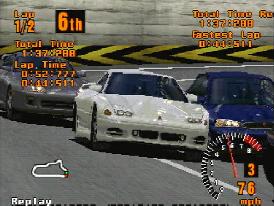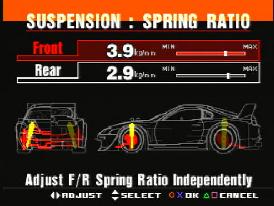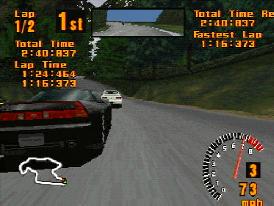As close to racing a modified Viper as I’ll ever get.
Racing reviews are some of the most difficult to write. It’s hard to make them
sound particularly different. I mean… whether the game is good or bad, you
select a car, you pick a track; then you drive the car around the track. Fast,
if possible.
Indeed, this is also the fundamental premise of Gran Turismo from Sony.
So lets take all that for granted, and focus on how Gran Turismo is different.
This may take a while, because there is more depth and detail to this racing
sim than anything I’ve seen before.
The first thing that caught my eye about Gran Turismo was totally unexpected.
My initial race was pretty underwhelming, as I drove my white Toyota Supra directly
into last place. Nice high framerate, good looking track, but nothing I hadn’t
seen in other modern racers like Need for
Speed 3. Then the replay began, and for perhaps the first time in my life,
I didn’t skip it. It looked terrific (not my untalented driving, but the replay
itself). Thanks to detailed tracks, high-polygon cars, television-like camera
shots and pans, and a great light reflection trick, the replay looked… real.
I watched five other cars trounce me, and I was entranced. Every faulty driving
move I made was recorded perfectly. I could see all the cars react to acceleration
and braking. I could watch all four tires react independently as I cut a turn
too close and drove over the inside curb. I watched as centripetal force leaned
my car onto the outside suspension, my rear tires sliding out, sending the car
into an ungraceful spin as I tried frantically to countersteer. You can even
save these replays for later viewing and analysis. This was my first clue that
there was more to this game than just going around the track fast.
The sound was pretty good overall. The music consists of real cuts by real
bands, which is bold, but I didn’t really like them as they were of extremely
average quality. I much preferred to turn off the game music and put in my Doors
CD. The tire squeals were good, and the engine noises of each car sounded different,
which is very impressive for a reason you’re about to learn.
 Have
Have
you ever wanted to race that Honda Civic of yours? Ever pop the clutch on your
Toyota Celica and pretend you were Mario Anrdretti on that empty rural road?
If you’ve ever owned a Japanese car, chances are you can race a replica of it
in Gran Turismo. There is a whopping total of 166 different cars
from 11 different manufacturers, though European and American car companies
are under-represented. It also may take a few minutes for you American players
to find your car, as they all use the British model names.
Gran Turismo’s Arcade Mode is like all the other racing games you’ve played.
There are a bunch of cars to choose from, 3 skill levels, and 4 tracks on which to race. Race well and you can get lots of additional cars and 4 new tracks.
The 2 player mode runs split screen and the graphics stay nice and smooth.
It is the Simulation mode where you really discover the inner workings of
the game. You start with 10,000 ‘credits’ with which you can buy, say, a used
Honda Prelude. Race it in some ‘spot races’ (no special license required) and
you can win enough money to soup it up a bit. A new exhaust system, some softer
tires or a sports suspension.
The amazing part is that Gran Turismo takes all of this into account
and represents it in the performance of your car. This includes traction, weight,
load balance, gear ratios, downforce, and lots of other technical racing jargon.
For example, buy a racing suspension, and before each race you can modify the
car height (front and rear), spring rate, shock damping and camber angle. With
166 different cars and the ability to change everything from the spoiler to
the computer ROM that controls the engine, the possible combinations must run
to into the millions. Some of the better Formula 1 simulators have had this
kind of detail, but frankly, all those cars feel the same. When you can switch
from an Acura NSX to a Corvette, you’ll really notice the difference in the
weight, even if the performance is similar.
Of course, it will take a number of successful races before you can afford
either of those cars. And once you have a better car, its time to think about
getting a racing license. You can test into a ‘B’ class license, an ‘A’ class
and an international ‘A’ class. These are very difficult to get and the tests
are extremely hard. To pass them you will need to master weight transfer techniques,
cornering lines, hitting the apex, sliding, spin turns, braking drift, faint
motion and inertial drift. Then you must learn to use them on 11 different tracks.
All of these advanced driving techniques are covered in the extensive manual.
 This may
This may
get actually get a bit too detailed and complicated for many casual racers.
How many millimeters off the ground should I set my Nissan Fairlady? I didn’t
even know what a ‘camber angle’ was before I played Gran Turismo. I’m
still not sure what kind of stabilizers I should buy for my Viper: “Used skillfully,
they can reduce lateral load change without interfering with longitudinal load
transfer.” This is no Mario Kart.
Win some races, and your prize will include a new car. You can keep a garage
full of different cars and use them for different kinds of races, or certain
classes. One of the race series, for example, only allows front wheel drive
cars. The depth here is close to that of a RPG game, and of course you can save
your progress. You’ll need to as it will take many, many hours to afford that
500,000-credit race car of your dreams, not to mention qualifying for the license
to drive it. You can even save your favorite souped-up car on a memory card
and race it against your friend’s best cars.
Now obviously no game is all rainbows and lollipops. Once you fork over $50
for Gran Turismo (which I recommend), be prepared to spend some more
money. Saving your replays, custom cars, and progress in simulation mode can
use up whole memory cards and then some. Also, the incredible precision and
detailed simulation of the game makes it nearly impossible to drive with the
clunky digital controller pad. If you are ever going to stand a chance of getting
that ‘A’ class license, you will need an analog controller, preferably a steering
wheel and pedal rig.
However, I think the biggest flaw with Gran Turismo is that there is
no damage modeling. You can turn on the tire damage option, which includes regular
wear and tear, but that is it. There is no way to really crash your car. You
can hit that wall at 200 KPH and you won’t even get a scratch. It detracts from
the simulation feel of the game that you can take a turn too fast, smack into
the outside wall, and keep going, sometimes without even losing your position
in the pack. Something to fix for Gran Turismo 2?
Reviewer’s note: I have been
informed (6/26/98) that the reason you cannot damage the cars in Gran Turismo
is that the car manufacturers (Toyota, Nissan, Dodge, etc.) forbade it as a
condition of the licensing. Apparently they feel that consumer confidence might
be shaken if it were publicly known that your cars could be damaged if you crash
them. I hereby place a gypsy curse on all car manufacturers.
But this is the only flaw I could find to gripe about. The rest of the game
is just fantastic. There is simply no other racing game for the PSX with the
same graphic quality, depth, detail, and replay value. This is an absolute must-buy
for racing fans, and is still highly recommended for everyone else. Gran
Turismo earns a rare ‘A’.







